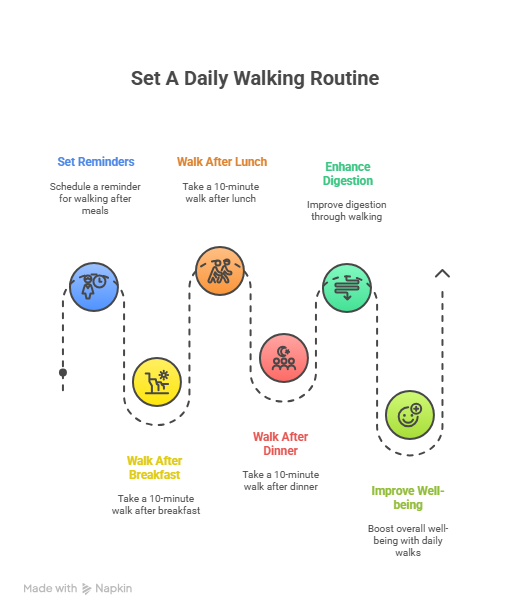
Chapter 5: Increase Physical Activity
Chapter 5: Increase Physical Activity
What does it mean to increase physical activity?
It means moving your body more often and more intentionally—but it doesn’t have to mean the gym or intense workouts. Even walking, or doing housework counts.
When we say “increase activity,” we’re talking about getting out of a sedentary routine and adding movement that helps your muscles use up glucose, so there’s less sugar floating around in your blood.
More physical activity will burn calories from sugar in your blood and fat in your body. In addition, more intense activities will help build muscle that will increase your metabolism to burn more calories even at rest.
You don’t have to exercise like an athlete. You just need to move more often and more consistently.
Where can you add more movement into your day?
The beauty of physical activity is that it can happen anywhere, and often without equipment.
🏡 At home – house chores, dancing, walking around while on the phone
👟 In your neighborhood – a walk or cycle around the block or local park
🧘 In the office – walk during breaks, use stairs
🏋️♂️ In your routine – short workouts, doing aerobics, yoga on YouTube
🛒 While out – park further, take stairs, walk instead of waiting
Physical activity isn’t just about “exercise”—it’s about creating a lifestyle of movement.
When should you be physically active?
✅ After meals – This is one of the BEST times to move. Even a 10-minute walk after eating can dramatically lower your blood sugar.
✅ In the morning – Movement early in the day sets your metabolism up for success
✅ During energy slumps – A short walk can work better than coffee
✅ On a schedule – Regularity helps your body regulate blood sugar better
✅ When you feel anxious or stressed – Movement helps lower cortisol, which also affects blood sugar
You don’t need to spend hours. Just 10–30 minutes a day can make a real difference.
Why does physical activity help reduce high blood sugar?
Because movement activates your muscle cells, and muscle cells use sugar for fuel—with or without insulin.
Here’s what happens when you move:
🔥 Your muscles pull sugar from the blood ⇒lower glucose
💪 Your insulin sensitivity improves ⇒ less resistance over time
🧘 It reduces stress hormones that cause sugar spikes
📉 It helps manage weight and body fat, which also affect blood sugar control
💊 It works hand-in-hand with medications or can reduce the need for them
It’s like giving your body a helping hand to do what it’s meant to do.
How do you move more—realistically and consistently?
Start small, stay consistent. Focus on what you can do, not what you think you should do.
✅ Walk for 10–15 minutes after each meal
✅ Set a timer to get up every hour and walk or pace
✅ Dance while cooking or cleaning
✅ Do short 5- to 10-minute workouts at home (bodyweight squats, wall push-ups, step-ups)
✅ Try yoga or tai chi if you want gentle movement
✅ Find a movement buddy or use an app to track progress
Don’t let “I’m too busy” stop you—movement is medicine and it’s free.
🍽️ Simple Blood Sugar-Friendly Recipe
🍗 Grilled Chicken Veggie Bowl (Post-Walk Fuel)
Ingredients (Serves 1):
1 skinless chicken thigh or breast (grilled or pan-seared)
1 cup steamed or sautéed broccoli
½ cup sautéed bell peppers
1 tbsp olive oil or butter
A sprinkle of sesame seeds or chopped almonds
Optional: 1 tbsp plain Greek yogurt on the side
Instructions:
Grill or pan-sear chicken until cooked through.
Sauté veggies in olive oil or steam and season lightly.
Assemble in a bowl, top with sesame seeds or almonds.
Nutritional Info (approx.):
Calories: 340 kcal
Protein: 30g
Carbs: 7g (mostly from vegetables)
Fats: 22g
Fiber: 5g
Sugar: <2g
Key nutrients: Zinc, selenium, B6, vitamin C, calcium
Benefits:
✅ Excellent post-activity recovery meal
✅ High protein and healthy fats
✅ Low in carbs, rich in fiber
✅ Supports muscle recovery and blood sugar control
👀 Visual Tip: The "Move After Meals" Rule
🚶♂️ 10-minute walk after meals = better blood sugar
Studies show just a short walk after eating can lower blood sugar spikes significantly.
🕒 Set a reminder: “Walk for 10” after breakfast, lunch, and dinner.
It could be the easiest and most effective habit you build for your health.


